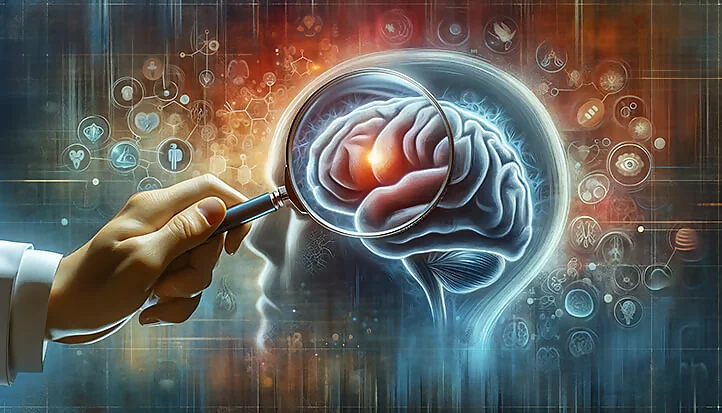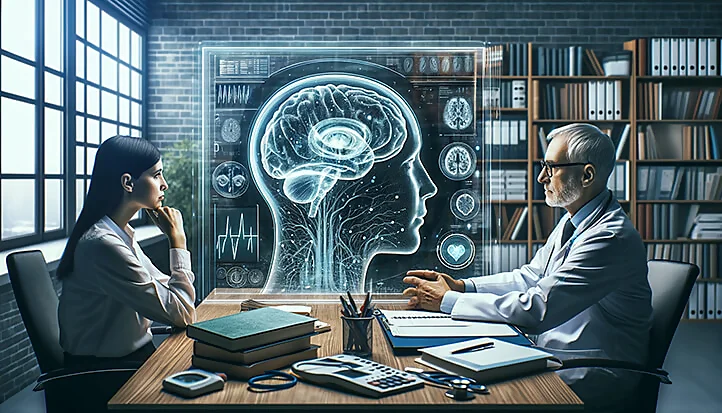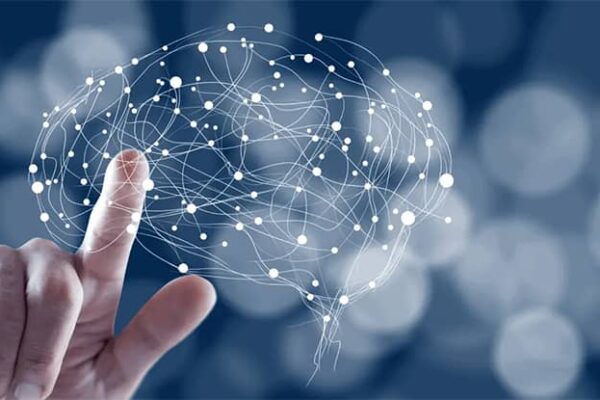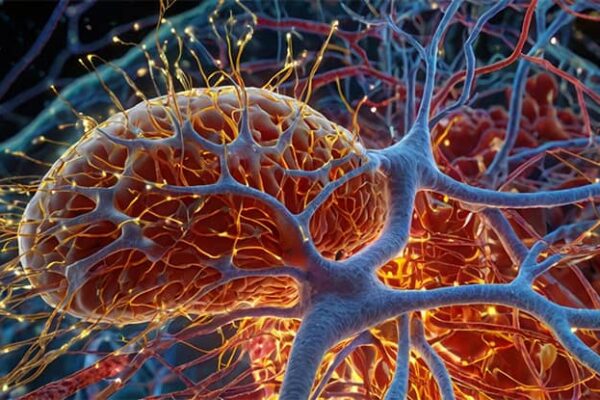Alzheimer’s disease is a progressive neurological disorder that leads to the decline of cognitive functions and memory, ultimately limiting a person’s ability to perform everyday tasks.
Being the most common cause of dementia among elderly people, the disease typically occurs after the age of 65, though it can sometimes develop earlier. The symptoms of Alzheimer’s disease progress gradually and worsen over time, starting with mild forgetfulness and eventually leading to severe impairments in mental function.
In the early stages, the disease may involve difficulties in remembering recent events or information. As the disease progresses, serious memory impairment, speech difficulties, disorientation in space and time, mood and behavior changes, as well as a decline in self-care abilities occur. In the later stages, patients require constant care.
The causes of Alzheimer’s disease are not fully understood, but it is believed that a combination of genetic, lifestyle, and environmental factors influence the risk of developing the disease. The accumulation of beta-amyloid and tau protein in the brain plays an important role, leading to the formation of amyloid plaques and neurofibrillary tangles, disrupting the normal functioning of neurons and causing their death.
At present, treatment for Alzheimer’s disease is focused on alleviating symptoms and slowing the progression of the disease, but a full cure remains impossible. Therapy includes the use of medications aimed at improving brain function, as well as supportive methods such as physical therapy, social support, and special training programs to maintain cognitive functions at the highest possible level.
Alzheimer’s disease is the most common form of dementia, affecting millions of people worldwide. Here are some key statistical data regarding its prevalence:
- Global prevalence. According to estimates by the World Health Organization (WHO), about 50 million people globally live with dementia, and most of them suffer from Alzheimer’s disease. By 2030, this figure is expected to rise to 82 million, and by 2050, to 152 million.
- Prevalence by age. The risk of developing Alzheimer’s disease significantly increases with age. About 3% of people aged 65 to 74, 17% of those aged 75 to 84, and nearly 32% of individuals over the age of 85 live with the disease.
- Gender. Women are more prone to developing Alzheimer’s disease than men, partially due to their longer life expectancy.
- Economic burden. Alzheimer’s disease and other forms of dementia place a significant economic strain on healthcare systems, society, and patients’ families. In 2019, the global cost of dementia care was estimated at approximately $1 trillion, and it is expected to double by 2030.
These statistics highlight the scale of the Alzheimer’s disease problem and the need for global efforts in researching the disease, improving patient care, and developing new methods of treatment and prevention.
Alzheimer’s disease represents a significant public health challenge, exacerbated by the unprecedented aging of the global population. As the proportion of elderly people in society increases, so does the number of those suffering from Alzheimer’s disease and other forms of dementia. This leads to a higher demand for medical services, care, and support, emphasizing the need for global efforts to provide adequate care for this population group.
The disease places a heavy economic burden on society, including direct medical costs and indirect costs related to the loss of productivity of caregivers. Global economic costs associated with dementia care continue to rise, making Alzheimer’s disease not only a medical issue but also a socio-economic challenge.
The importance of the Alzheimer’s disease problem at the present stage is driven not only by medical and social aspects but also by the need for global efforts to develop effective strategies to combat this growing threat. This underscores the necessity of investing in research, improving care and support for patients and their families, as well as raising public awareness and understanding of this complex issue.

What is Alzheimer’s Disease?
Alzheimer’s disease is a neurological condition characterized by the gradual loss of memory and other important cognitive functions necessary for performing daily activities. It is the most common cause of dementia, a condition describing a range of symptoms related to the decline of memory, thinking, and behavior. Over time, the disease progresses, leading to severe intellectual impairments, behavioral changes, and deterioration in the ability to interact with others.
The classification of Alzheimer’s disease is usually based on the stages of disease progression, which can range from mild cognitive impairment to severe dementia:
- Pre-dementia stage or mild cognitive impairment. At this stage, there is slight memory impairment that does not affect daily activities. People with mild cognitive impairment are at a higher risk of developing Alzheimer’s disease, but not everyone progresses to more serious stages.
- Early stage of Alzheimer’s disease. At this point, patients begin to experience difficulties remembering recent events and new information and may encounter problems with planning and performing daily tasks.
- Moderate stage of Alzheimer’s disease. This is the longest stage, during which cognitive functions, including speech, comprehension, reading, and writing, deteriorate. Disorientation, increased irritability, and sometimes hallucinations appear.
- Late stage of Alzheimer’s disease. At this stage, patients lose the ability to live independently. They require constant care due to severe memory impairment, motor dysfunction, and other bodily functions. Verbal communication ability decreases, and physical abilities deteriorate to the point where the patient cannot move independently.
The diagnosis and classification of Alzheimer’s disease require a comprehensive approach, including medical examinations, neurological tests, and, in some cases, brain scans. It is important to note that early diagnosis and appropriate medical intervention can help slow the progression of symptoms and improve the quality of life for patients.
A brief history of discovery and research
Alzheimer’s disease was first described by German psychiatrist and neurologist Alois Alzheimer in 1906. The discovery occurred when Alzheimer studied the case of his patient, Augusta Deter, who suffered from symptoms of severe memory loss, speech difficulties, and paradoxical behavior.
After her death, during an autopsy of the brain, Alzheimer discovered unusual cellular changes, including the presence of thread-like inclusions (later called neurofibrillary tangles) and plaques (now known as amyloid plaques) in the brain, which he suggested were the cause of her condition.
In the years following Alzheimer’s initial description, the disease was considered a rare condition observed mainly in younger patients. However, as neurology advanced and diagnostic methods improved, it became clear that symptoms similar to those described by Alzheimer were found in a large number of elderly people.
Since the 1960s, Alzheimer’s disease has been recognized as the most frequent cause of dementia among older adults, which led to a significant increase in global research interest.
Since then, significant progress has been made in the study of Alzheimer’s disease. The main research directions include studying genetic risk factors, mechanisms of the formation and accumulation of amyloid plaques and neurofibrillary tangles, as well as the development of methods for early diagnosis and new approaches to treatment.
In recent years, special attention has been given to finding biomarkers for the disease that could help in its early detection and studying the impact of lifestyle on the risk of developing the disease.
Despite significant research efforts, Alzheimer’s disease remains incurable, and most existing therapeutic strategies are aimed at alleviating symptoms and improving the quality of life for patients. Efforts to find effective methods of treatment and prevention continue, making this field one of the key areas in modern medical science.

Symptoms of Alzheimer’s Disease
Alzheimer’s disease slowly and relentlessly invades a person’s mind, gradually overshadowing the clarity of thoughts and memories that were once an integral part of their essence. It begins with minor forgetfulness, which many tend to attribute to regular fatigue or age-related changes. However, over time, the symptoms deepen, leaving a noticeable mark on a person’s ability to lead their usual life. The world, once full of colors and sounds, gradually dims, turning everyday tasks and recognizing familiar faces into insurmountable obstacles.
Behind each case of the disease is the unique story of a person facing this condition. Although the general outline of symptoms may be similar, each patient goes through their own journey through the fog of memory loss and cognitive impairments. This journey, unfortunately, is marked by a loss of the ability to manage thoughts and actions in the way they once could.
Understanding the symptoms of Alzheimer’s disease is key to early diagnosis and disease management. It helps families and healthcare workers create a supportive environment that fosters the preservation of dignity and quality of life for patients at different stages of the illness.
Early Signs and Symptoms
Early signs and symptoms of Alzheimer’s disease can initially be easily confused with the typical signs of aging or stress. However, it is these early signals that may indicate the onset of cognitive changes associated with the disease. It is important to pay attention to the following symptoms, which may require further examination and consultation with a specialist:
- Forgetfulness that affects daily life. The most noticeable early sign is forgetfulness, especially of new information. People may forget important dates or events, ask the same questions multiple times, and increasingly rely on written or electronic reminders.
- Difficulty performing familiar tasks. Individuals may encounter problems completing tasks they previously managed easily, such as driving to a familiar place, organizing a shopping list, or remembering the rules of a favorite game.
- Loss of orientation in time or space is also a common sign. People may forget where they are and how they got there or become confused about the day of the week.
- Visual and spatial problems. Some may experience difficulties with reading, determining distances, colors, or contrast, which can, for example, affect their ability to drive.
- New problems with words in speech or writing. There may be trouble finding the right words, following the topic of a conversation, or participating in discussions. A person might stop mid-conversation and not know how to continue or repeat themselves.
- Misplacing things. People with early symptoms of Alzheimer’s often put things in unusual places and then cannot recall their actions to find them. Sometimes, they accuse others of theft in such situations.
- Impaired judgment. There may be issues with decision-making, particularly in financial matters, or a decline in hygiene, despite previous positive habits in this regard.
- Withdrawal from social activities or work. Due to the difficulties mentioned above, the person may start avoiding hobbies, social events, work, or sports they previously enjoyed.
- Mood and personality changes. A shift in mood and personality may occur, such as becoming depressed, frightened, irritable, or suspicious of others.
Recognizing these signs and symptoms early and seeking medical attention can greatly aid in managing Alzheimer’s disease, allowing measures to be taken to slow its progression and maintain quality of life.
Progressive Symptoms
As Alzheimer’s disease progresses, the symptoms become more pronounced and significantly impact a person’s daily life. Progressive symptoms may include:
- Worsening memory. Memory continues to deteriorate, affecting both recent and long-term memories. People may not recognize close family members and friends, forget significant events in their lives, and lose the ability to recall personal information.
- Increased disorientation. Patients may become lost even in familiar environments, unable to comprehend the current time, date, or place, and experience difficulty perceiving time intervals.
- Deterioration in speech and writing. Understanding the speech of people with Alzheimer’s becomes increasingly challenging. They experience issues with grammar, spelling, and sentence construction.
- Changes in behavior and personality. Apathy, social withdrawal, depression, aggression, anxiety, suspicion, or paranoia may develop. Mood swings become more frequent and unpredictable.
- Decline in self-care. Patients may have difficulty performing daily tasks, such as dressing, personal hygiene, eating, and using the toilet, requiring additional assistance from caregivers.
- Problems with movement and coordination. Physical abilities decline, including walking, balance, and coordination, increasing the risk of falls.
- Increased dependency on external help. As the condition worsens, patients’ ability to live independently decreases, making them increasingly reliant on external support and care.
- Sleep disturbances. Changes in sleep patterns, nighttime insomnia, and daytime sleepiness become common.
- Difficulty chewing and swallowing, often leading to weight loss and nutritional issues.
These progressive symptoms affect not only the patients but also have a profound impact on their families, requiring them to adapt and change their approach to care and communication.
Late Stages of Alzheimer’s Disease and Their Features
In the late stages of Alzheimer’s disease, symptoms become so severe that they affect a person’s ability to function in daily life, requiring constant, round-the-clock care. Features of the late stages include:
- Complete dependence on external assistance. At this stage, individuals are unable to take care of themselves and need constant help with daily tasks, including personal hygiene, dressing, eating, and mobility.
- Severe memory loss. Most people at this stage completely lose the ability to remember and recognize close relatives and friends. Long-term memories may also become blurred or entirely disappear.
- Severe speech impairment. The ability to communicate significantly declines. Individuals may utter incomprehensible or repetitive sounds, words, and phrases, or lose the ability to speak altogether.
- Physical difficulties. Disease progression leads to a significant deterioration in physical condition, including weakness, problems with coordination and mobility, often necessitating the use of a wheelchair or complete bedrest.
- Feeding issues. Patients may have difficulty swallowing, requiring dietary adjustments, and in some cases, feeding through a tube.
- Behavioral changes. Anxiety, irritability, and in some cases, aggression or, conversely, apathy, may be observed. Other psychological symptoms, such as hallucinations or paranoia, may also occur.
- Loss of control over bodily functions. Incontinence becomes common, requiring the use of diapers and specialized care.
The late stages of Alzheimer’s disease demand significant effort, patience, and understanding from caregivers, highlighting the need for comprehensive support for both patients and their families.

Causes of Alzheimer’s Disease
The question of why some people face Alzheimer’s disease while others go through old age with clarity of mind remains a subject of extensive scientific research and debate. Alzheimer’s disease, named after Dr. Alois Alzheimer, who first described it over a century ago, continues to raise questions that scientists worldwide are seeking to answer. The complexity of this disease and the variety of factors that may contribute to its development make understanding its causes particularly relevant for developing effective prevention and treatment methods.
For decades, researchers have tried to unravel the mystery of Alzheimer’s disease by studying various factors that may influence the risk of developing this condition. The importance of these studies cannot be overstated, as they can shed light on the mechanisms underlying the disease and open new avenues for its prevention and treatment.
Understanding the causes of Alzheimer’s disease is not just of academic interest. Such knowledge has immediate practical value, as it can help millions of people worldwide avoid or slow the progression of this devastating condition. Every new discovery in this area brings us closer to answers that could change the lives of many individuals and families affected by the disease.
Genetic Factors
Genetic factors play a significant role in the development of Alzheimer’s disease, although the degree of their influence can vary greatly depending on each specific case. Research shows that heredity contributes to both early and late onset of the disease, highlighting the complexity of the interaction between genetic and environmental factors.
Early Onset Alzheimer’s Disease
Early onset Alzheimer’s disease, which typically occurs before the age of 65, is often associated with specific genetic mutations. The most well-known mutations are found in the following genes:
- APP (Amyloid Precursor Protein)
- PSEN1 (Presenilin 1)
- PSEN2 (Presenilin 2)
These mutations lead to changes in the production of beta-amyloid, contributing to the formation of amyloid plaques, one of the key pathological hallmarks of Alzheimer’s disease. The presence of these mutations can significantly increase the risk of developing the disease, often with a high degree of heritability.
Late Onset Alzheimer’s Disease
The more common form of Alzheimer’s disease usually manifests after the age of 65 and is associated with other genetic factors. The most studied genetic risk factor for this form of the disease is the APOE (Apolipoprotein E) gene. There are different variants of this gene, but one variant, APOE ε4, increases the risk of developing the disease. However, having APOE ε4 is neither a necessary nor sufficient condition for developing the disease, indicating the influence of additional factors.
Research and Perspectives
Ongoing genetic research on Alzheimer’s disease includes studying other potential genes that may contribute to the development of the condition, as well as mechanisms through which genetic factors interact with the environment and lifestyle. The discovery of new genetic markers could improve the understanding of the biology of the disease and facilitate the development of targeted treatments and preventive strategies.
Thus, although genetic factors play a key role in the development of Alzheimer’s disease, they interact with a variety of other factors, creating a complex picture of the risk and progression of the disease.
External and Internal Risk Factors
In addition to genetic predispositions, the development of Alzheimer’s disease may be linked to various external and internal risk factors that increase the likelihood of its onset and progression.
External Risk Factors
- Lifestyle and cardiovascular factors. Unhealthy lifestyles, including smoking, lack of physical activity, poor diet, and obesity, can increase the risk of developing Alzheimer’s disease. Cardiovascular factors such as hypertension, diabetes, high cholesterol, and obesity are also associated with a higher risk.
- Head injuries. Severe head injuries, especially those accompanied by loss of consciousness, can increase the likelihood of developing Alzheimer’s disease later in life.
- Social interaction and mental activity. Scientists associate a low level of social interaction and mental stimulation with an increased risk of dementia. Active participation in social life and regular mental exercises help reduce this risk.
- Environmental factors and toxin exposure. Some studies suggest that prolonged exposure to certain environmental toxins, such as heavy metals and pesticides, may increase the risk of developing Alzheimer’s disease.
Internal Risk Factors
- Age. The most significant risk factor for Alzheimer’s disease is age, with the risk of the disease increasing significantly after the age of 65.
- Gender. Research shows that women are at a higher risk of developing Alzheimer’s disease compared to men, which may be related to longer life expectancy and other genetic and biological factors.
- Family history and genetics. Having relatives with Alzheimer’s disease increases the risk of developing the condition, especially if multiple family members are affected or if the disease was diagnosed at a young age.
- Comorbidities. Certain chronic conditions, such as cardiovascular disease, type 2 diabetes, and depression, can increase the risk of developing Alzheimer’s disease.
Modern Theories of Disease Onset
Modern theories of Alzheimer’s disease onset explore various biological mechanisms and factors that may contribute to the development of this condition. Although the exact cause of the disease remains unidentified, the scientific community has highlighted several key theories that explain potential pathways of its development.
Amyloid Cascade Hypothesis
One of the most widely discussed theories, the amyloid cascade hypothesis, suggests that the accumulation of beta-amyloid in the brain is the primary event leading to the development of Alzheimer’s disease. According to this theory, excessive production or insufficient removal of amyloid-beta peptides leads to the formation of amyloid plaques, which disrupt neuron function and stimulate the creation of neurofibrillary tangles of tau protein. This, in turn, leads to neurodegeneration and dementia symptoms.
Tau Protein Hyperphosphorylation Theory
This theory focuses on pathological changes in tau protein, which plays a key role in stabilizing microtubules in neurons. Under normal conditions, tau protein helps maintain the structure and function of neural cells. However, in Alzheimer’s disease, it undergoes hyperphosphorylation, loses its function, accumulates, and forms neurofibrillary tangles, leading to neuronal dysfunction and death.
Inflammatory Hypothesis
According to the inflammatory hypothesis, chronic inflammation in the brain plays a central role in the development of Alzheimer’s disease. Inflammatory processes triggered by amyloid accumulation or other factors may contribute to neurodegeneration. The brain’s immune system, activating in response to amyloid deposits, may respond inadequately, damaging healthy neuronal cells.
Mitochondrial Dysfunction Theory
Mitochondria, which generate energy for the cell, may play a key role in the development of Alzheimer’s disease. The mitochondrial dysfunction theory suggests that mitochondrial damage and disrupted cellular energy metabolism lead to reduced neuron functionality and their subsequent death.
Brain Insulin Resistance Theory
Some studies suggest that brain insulin resistance contributes to the development of Alzheimer’s disease, giving it the unofficial name of “type 3 diabetes.” Insulin is important for the brain as it regulates glucose metabolism and participates in many cognitive processes. Insulin resistance can impair these functions and contribute to cognitive decline.
Each of these theories provides important insights into the mechanisms underlying Alzheimer’s disease and points to potential targets for developing new therapeutic strategies. Most likely, Alzheimer’s disease results from the interaction of multiple factors, making the investigation of its causes particularly challenging.

Diagnosis of Alzheimer’s Disease
In the process of unraveling the mystery of Alzheimer’s disease, diagnosis plays a key role, providing both doctors and patients with crucial information for understanding and managing the condition.
Over time, diagnostic methods have become increasingly accurate and sensitive, enabling the detection of the disease at early stages, even before the appearance of obvious symptoms. This progress allows for more effective treatment planning, care, and participation in clinical research aimed at exploring new therapeutic approaches.
The path to diagnosing Alzheimer’s disease begins with understanding that changes occurring in the brain may precede symptom development by many years. This highlights the importance of early detection and the possibility of interventions that may slow or even prevent the progression of the disease.
Nevertheless, diagnosis remains a complex task, requiring a comprehensive approach, including detailed medical history, neurological examinations, and modern brain imaging and laboratory tests.
Diagnostic Methods
Diagnosis of Alzheimer’s disease involves a comprehensive approach that combines clinical examination, neuropsychological testing, and modern brain imaging techniques. Below are the primary methods used to diagnose this condition:
Clinical Examination and Medical History
- Medical history: The doctor collects information about the patient’s medical history, family history of dementia, and symptoms that may indicate Alzheimer’s disease.
- Physical examination: A check of general health to rule out other possible causes of symptoms.
- Neurological examination: An assessment of reflexes, coordination, muscle strength, and eye movements to identify any neurological signs associated with Alzheimer’s disease or other conditions.
Neuropsychological Testing
- Cognitive function tests: An evaluation of memory, problem-solving abilities, attention, language skills, and other aspects of mental activity. Tests may include the Mini-Mental State Examination (MMSE) and the Montreal Cognitive Assessment (MoCA).
Brain Imaging Methods
- Magnetic Resonance Imaging (MRI): Allows doctors to see the structure of the brain and identify volume loss in certain brain regions, which may indicate Alzheimer’s disease.
- Computed Tomography (CT): Used to obtain images of the brain, helping to rule out other causes of symptoms such as tumors or strokes.
- Positron Emission Tomography (PET): Can be used to assess glucose metabolism in the brain or to detect amyloid deposits characteristic of Alzheimer’s disease.
Laboratory Tests
- Blood tests: Conducted to rule out other possible causes of symptoms, such as vitamin deficiencies or thyroid problems.
- Lumbar puncture (spinal tap): The analysis of cerebrospinal fluid helps detect biomarkers characteristic of Alzheimer’s disease, such as beta-amyloid and tau protein.
Although none of these methods alone can definitively diagnose Alzheimer’s disease, a combination of clinical evaluation, neuropsychological testing, and brain imaging allows doctors to confidently determine the presence of this disease.
It is important to note that diagnosing Alzheimer’s disease is a dynamic process that may involve regular monitoring and re-evaluations to track disease progression and adjust the treatment plan.
Early Detection and Its Importance
Early detection of Alzheimer’s disease plays a critically important role in managing the condition, allowing patients and their families to make the most of available resources and treatment strategies. Detecting the disease at an early stage offers several key benefits:
Treatment Planning
- Early treatment: Starting treatment early can slow symptom progression, improve quality of life, and prolong the patient’s independence.
- Access to new therapies: Patients with early-stage disease are suitable candidates for participation in clinical trials of new drugs and therapies.
Future Planning
- Legal and financial planning: Early detection allows patients to plan for their care, address legal and financial matters while they are still capable of making decisions.
- Family planning: Families have time to plan for caregiving, discuss the future, and prepare for changes that will occur in their lives.
Psychological Support
- Education and support: Early detection allows patients and their families to access informational resources and support groups that can help them adapt to living with the disease.
- Emotional acceptance: Although the diagnosis may be shocking, early detection provides time to process the information and emotionally accept the diagnosis, which is important for psychological well-being.
Advancing Research
- Contributing to science: Participation in early-stage research can help scientists better understand the mechanisms of Alzheimer’s disease and develop more effective treatments and preventive measures.
Differential Diagnosis
Differential diagnosis involves the process of ruling out other diseases that may cause symptoms similar to those of Alzheimer’s disease. This is an important step because many conditions can mimic or worsen the cognitive impairments characteristic of Alzheimer’s. Accurately identifying the cause of symptoms is critical for providing appropriate treatment and care planning. Below are some of the conditions that doctors aim to rule out when diagnosing Alzheimer’s disease:
Other Types of Dementia
- Vascular dementia: Caused by problems with the brain’s blood supply, often following a series of mini-strokes or one large stroke.
- Dementia with Lewy bodies: Characterized by abnormal protein deposits in the brain known as Lewy bodies, and may be accompanied by changes in perception, thinking, and behavior.
- Frontotemporal dementia (FTD): Encompasses a range of diseases affecting the frontal and temporal lobes of the brain, leading to changes in behavior and speech.
Mental and Neurological Disorders
- Depression, especially in old age, can mimic cognitive impairments, sometimes referred to as “pseudodementia.”
- Normal pressure hydrocephalus: A condition caused by the accumulation of cerebrospinal fluid in the brain’s ventricles, which can lead to walking problems, bladder control issues, and cognitive impairments.
- Chronic exposure to toxins, including alcohol and heavy metals, can cause symptoms resembling dementia.
Metabolic and Systemic Diseases
- Hypothyroidism (underactive thyroid) can lead to cognitive decline.
- Vitamin B12 deficiency can cause cognitive impairments and neurological symptoms.
- Infectious diseases such as HIV, syphilis, and Lyme disease can affect the brain and lead to cognitive disturbances.
Differential diagnosis may involve various methods, including blood tests, neuropsychological testing, brain imaging (MRI, CT, PET), and sometimes lumbar puncture to analyze cerebrospinal fluid. All of these help doctors accurately determine the cause of symptoms and prescribe the most effective treatment or support measures.

Alzheimer’s Disease Treatment
Treating Alzheimer’s disease remains a complex challenge, as no cure has been found yet. Current treatment approaches focus on relieving symptoms, slowing the progression of the disease, and improving the quality of life for patients and their families. Here are the main directions in Alzheimer’s disease treatment:
Medication Treatment
- Cholinesterase Inhibitors: Medications such as donepezil, rivastigmine, and galantamine are used to treat mild to moderate Alzheimer’s disease. They increase the level of a chemical in the brain called acetylcholine, which helps improve cognitive functions and the ability to perform daily tasks.
- NMDA Receptor Antagonists: Memantine is used to treat moderate to severe Alzheimer’s disease. This medication works by regulating the activity of glutamate, a neurotransmitter involved in learning and memory processes.
Non-Medication Treatments
- Cognitive Rehabilitation: Includes exercises and activities aimed at maintaining cognitive functions such as memory, attention, and problem-solving.
- Behavioral Therapy: Helps manage behavioral changes such as aggression, anxiety, or depression through behavior modification strategies and psychosocial support.
- Physical Exercise: Regular exercise helps improve overall well-being, maintain mobility, and reduce some symptoms of depression.
- Balanced Diet: A diet rich in fruits, vegetables, whole grains, and lean protein sources promotes overall health and well-being.
Supportive Measures
- Care and Support: Training on how to provide the best care for people with Alzheimer’s, including daily care, communication strategies, and safety measures.
- Future Planning: Consultations on legal and financial planning, including guardianship and wills.
Experimental Therapy
Research continues on new approaches, including immunotherapy aimed at reducing amyloid deposits in the brain, and drugs targeting other pathological processes such as tau protein accumulation and brain inflammation. Gene therapy and stem cell methods are also being explored.
It is important to note that Alzheimer’s disease treatment should be strictly individualized, taking into account the stage of the disease, the patient’s overall health, the presence of comorbid conditions, and the needs of the patient and their family. Regular medical supervision and adaptation of the treatment plan are essential to ensure the best care for the patient.

Alzheimer’s Disease Prevention
Preventing Alzheimer’s disease includes strategies and lifestyle choices aimed at reducing the risk of developing the disease. While there is no absolute guarantee of prevention, a number of recommendations can help reduce the likelihood of its occurrence or slow its progression.
- Maintaining Activity: Regular physical exercise improves circulation and contributes to mental health. Activity also helps control weight, blood pressure, and cholesterol levels.
- Balanced Diet: A diet rich in fruits, vegetables, whole grains, and lean protein sources supports overall health and may reduce the risk of developing Alzheimer’s. The Mediterranean or DASH diet is particularly recommended.
- Quitting Smoking and Moderate Alcohol Consumption: Smoking and excessive alcohol consumption increase the risk of developing Alzheimer’s and other forms of dementia.
- Continuous Learning and Brain Stimulation: Activities requiring mental effort, such as reading, solving crosswords, playing chess, learning a new language or musical instrument, help maintain brain functions.
- Social Activity: Supporting social connections and regular communication with friends and family contributes to emotional well-being and can reduce the risk of developing the disease.
- Controlling Chronic Conditions: Managing conditions such as diabetes, high blood pressure, and high cholesterol helps reduce the risk of developing Alzheimer’s.
- Preventing Head Injuries: Protecting the head during sports and using seat belts when driving, as well as helmets when rollerblading, biking, motorcycling, riding ATVs, etc., helps prevent brain injuries, which increase the risk of dementia.
- Monitoring and Early Detection: Regular medical check-ups help in the early detection and management of Alzheimer’s risk factors.
- Quality Sleep: Getting enough quality sleep helps clear toxins from the brain and reduces the risk of developing Alzheimer’s disease.
Preventing Alzheimer’s disease requires a comprehensive approach that includes physical health care, mental activity, and social interaction.

Research and the Future of Alzheimer’s Treatment
Research on Alzheimer’s disease is advancing rapidly, promising significant changes in the future of its treatment. Scientists around the world are working on developing new therapeutic strategies that could slow or stop the progression of the disease, reduce symptoms, and ultimately find a cure.
New Directions in Treatment
- Targeted therapies focus on specific molecular targets involved in the pathogenesis of Alzheimer’s disease, including beta-amyloid peptide and tau protein. Developing antibodies targeting these proteins may help reduce their pathological accumulation in the brain.
- Immunotherapy. Research is aimed at developing vaccines and monoclonal antibodies that can stimulate the immune system to destroy amyloid plaques or prevent their formation.
- Gene therapy. Studying the genetic factors contributing to Alzheimer’s disease opens up the possibility of gene therapy aimed at correcting molecular-level disorders.
- Neuroprotective strategies aim to protect neurons from degenerative processes.
Research on Lifestyle and Prevention
- Lifestyle impact. Studies confirm that physical activity, healthy nutrition, mental exercises, and social engagement reduce the risk of Alzheimer’s disease. These findings may lead to the development of comprehensive prevention programs.
- Early detection. Improving methods of early diagnosis, including blood biomarkers and new brain imaging techniques, may allow treatment to begin before clinical symptoms appear, improving patient outcomes.
Future Research
- Interdisciplinary approaches. Combining data from neuroscience, genetics, molecular biology, and epidemiology promises new discoveries in understanding the mechanisms of Alzheimer’s disease and developing treatments.
- Personalized medicine. Research is focused on creating personalized treatment and prevention strategies for Alzheimer’s disease, considering individual differences in genetics, lifestyle, and risk factors.
Progress in Alzheimer’s research continues to inspire hope for a future where we have far more tools to combat this disease. Each new discovery increases the likelihood that we will be able to prevent, effectively treat, and possibly even cure Alzheimer’s one day.

Care Tips for People with Alzheimer’s Disease
Caring for someone with Alzheimer’s disease requires significant effort, patience, and understanding. Here are some tips to help make the process easier:
- Minimizing fall risks. Remove unnecessary items from the floor, ensure adequate lighting, and install handrails in the bathroom and toilet.
- Predictability. Maintain a consistent daily routine to help the patient orient themselves in time and space.
- Simplicity and clarity. Use simple phrases and ask questions that require brief answers.
- Non-verbal cues. Pay attention to gestures, facial expressions, and tone of voice, which can aid in communication.
- Patience and positivity. Stay calm and patient, even if you need to repeat things. Maintain a positive attitude.
- Help with personal hygiene and dressing. Offer assistance but allow the person with Alzheimer’s to do what they can on their own to maintain their independence.
- Meal organization. Choose balanced meals and use contrasting colors for dishes and food to aid perception.
- Managing irritability. Play calming music, reduce environmental irritants, and ensure physical activity for the patient.
- Monitoring movements. Install extra locks and use GPS devices or ID bracelets for safety.
- Informational resources. Use available resources and educational materials from organizations dedicated to Alzheimer’s disease.
- Professional help. Don’t hesitate to seek professional help when needed, including medical, social, and psychological support.




